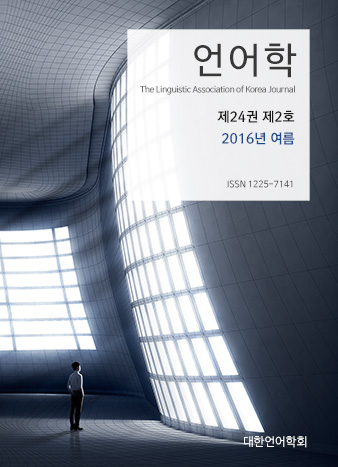대한언어학회 전자저널

-
A Corpus-based Study on the Use of English Present Perfect by Chinese EFL Learners
-
A Study of Curricular Components of English/Korean-Language Textbooks
-
The Effects of Listening Encoding Strategy Use on Korean EFL Learners’ EAP Listening Comprehension
-
A Study on the Correlation between Self-Efficacy Beliefs and Strategies in English Reading
Abstract
Keywords
# 등종속(cosubordination) # 의미역지시문법(RRG) # 정쳐-넥서스(juncture nexus) # AND-언어/WITH-언어(AND-languages/WITH-languages)
References
- 강영세. (2006). and-등위접속의 화용론. 어문학논총, 25. 197-205.
- 권재일. (2012). 한국어 문법론. 서울: 태학사.
- 김건희. (2014). 대등과 종속에 관한 일고찰. 인문논총, 71(3), 117-157.
- 송경안 송진희. (2006). 등위접속구문의 유형론적 연구. 독일언어문학, 31. 73-97.
- 이관규. (1999). 대등문 종속문 부사절 구문의 변별 특성. 선청어문, 27. 753-780.
- 조의연. (2003). 인지의미론에서 본 영어 상호-사건 관계 ‘and’ 접속구문: 진정한 등위접속인가? 담화와인지, 10(2), 177-195.
- Culicover, P. and R. Jackendoff. (1997). Semantic subordination despite syntactic coordination. Linguistic Inquiry, 28, 195-217.
- Feldman, A. (2002). On NP-coordination. In S. Baauw et al.(Eds.), The UiL OTS 2002 Yearbook(pp. 39-66). Utrecht, the Netherlands.
- Foley, W. and R. Van Valin. (1984). Functional syntax and universal grammar. Cambridge: Cambridge University Press.
- Haspelmath, M. (2007). Coordination. In Shopen, T.(Ed.), Language typology and syntactic description: Complex constructions(pp. 1-51). Cambridge: Cambridge University Press.
- Haspelmath, M. (2004). Coordinating constructions. Amsterdam: John Benjamins.
- Heycock, C. and R. Zamparelli. (2005). Friends and colleagues: plurality, coordination, and the structure of DP. Natural Language Semantics, 13, 201-270.
- Kwon, N. (2004). Syntactic and semantic mismatches in the Korean ko-construction. WCCFL 23 Proceedings, 101-114.
- Li, C. and S. Thompson. (1976). Subject and topic: A new typology of language. In C. Li(Ed.), Subject and topic(pp. 457-490). New York: Academic Press.
- Sohn, H. (1999). The Korean language. Cambridge: Cambrdige University Press.
- Stassen, L. (2001). Noun phrase coordination. In M. Haspelmath, E. König, W. Oesterreicher and W. Raible(Eds.), Language typology and language universal(pp. 1105-1111). Berlin: Mouton de Gruyter.
- Stassen, L. (2000). AND-languages and WITH-languages. Linguistic Typology, 4, 1-54.
- Talmy, L. (2000). Toward a cognitive semantics(vol. 1). Cambridge, Mass.: MIT Press.
- Van Valin, R. (2001). The acquisition of complex sentences: a case study in the role of theory in the study of language development. ms. SUNY at Buffalo.
- Van Valin, R. (2005). Exploring the syntax-semantics interface. Cambridge: Cambridge University Press.
- Van Valin, R. (2014). On the place of information structure in a grammar. From http://wings.buffalo.edu/linguistics//people/faculty/vanvalin/rrg
- Yang, B. (1994). Morphosyntactic phenomena of Korean in Role and Reference Grammar: Paych-verb constructions, inflectional verb morphemes, complex sentences, and relative clauses. Ph.D. dissertation, SUNY at Buffalo.